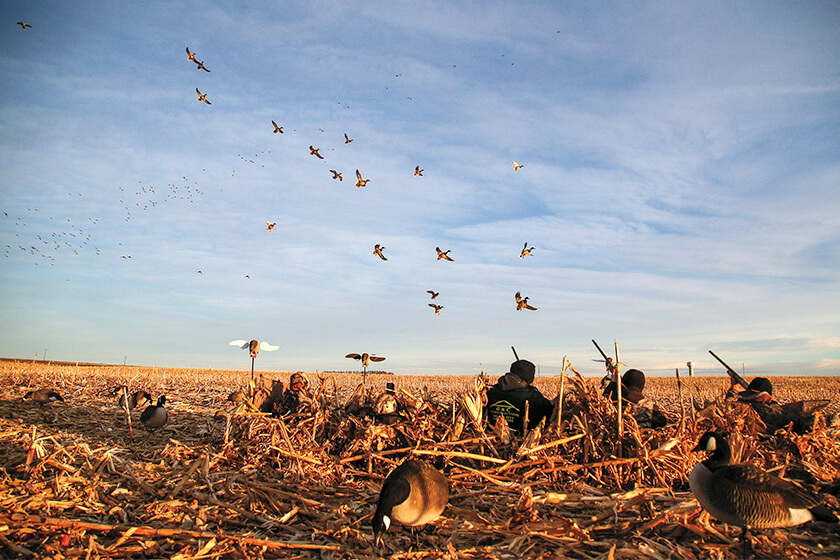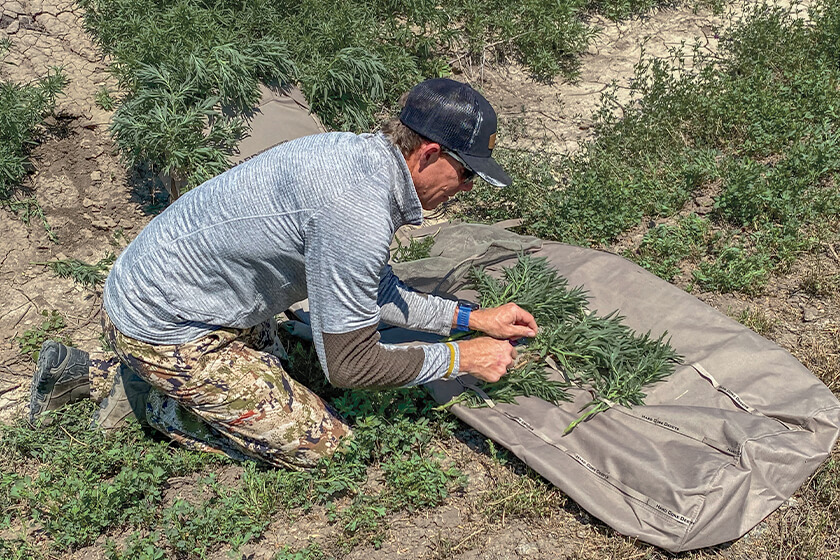
Today’s layouts are built with the waterfowler in mind. They are customizable and come with many smart, convenient amenities that will make you more comfortable and more successful. (Dean Pearson photo)
A swather had just trimmed the miniature alfalfa field, and there was nowhere to hide. We scanned the field edges and surrounding ditches, but the farmer that owned the dirt was just too clean of an operator. Obviously, he was a fan of Roundup, and our goose crew felt helpless as we watched flight after flight of early-season birds pour into the field. We had the geese. We had the permission. We just didn’t have a hide.
Not one of us owned a layout. Full-time college students, our funds were limited, but we always seemed to find a way to get it done. We’d crouch into concrete ditches, use tumbleweeds, shovel holes in plowed earth and cover up with corn-stubble-filled chicken wire. None of that was an option. All we had to work with were a few broken bails of alfalfa the farmer said we could use for cover. On a whim, we made a four-hour drive to Cabela’s. We scraped together our life savings and invested in three layout blinds. Two days later, after dropping seven geese out of a group of honkers in the empty alfalfa field, my buddy looked at me, grinned, and said, “Well, we are stupid. These things are game-changers. We can hunt anywhere and everywhere in total comfort and flare far fewer birds.”
He was right. Layouts changed our approach to how we hunted ducks and geese. We used them around sparsely-covered ponds, in plowed cornfields, and in the middle of isolated river sandbars. If you don’t own a layout, you don’t know what you’re missing.
Of course, there is the argument that layouts have become obsolete — replaced by pricy pit blinds and the like. I beg to differ. If you’re a mobile waterfowl hunter and spend your season chasing birds across varying landscapes, a layout is the only way to go.
More Public Than Ever
Wildlife departments around the country have done a fantastic job working with landowners to open more ground to hunters. These are private acres of dirt that have been opened to the public and offer excellent waterfowl hunting. The thing to know is most programs limit use to walk-in access. This means no driving to the middle of a plowed field or off-the-beaten path marsh. You’ll have no chance to dig a pit or alter the landscape in any way.
If public land waterfowling is your jam, a lightweight layout is a must-have item. I recommend one with backpack straps, and if possible, a model that allows you to tote your shotgun along with a few decoys and other essentials into the field. One of my favorites is the Run-N-Gunner from Hardcore. This blind offers no-pin construction, padded backstraps, and comes with an attached decoy bag. The layout sets up in seconds and allows the hunter to keep an extremely low profile. For the money, it’s tough to beat. So many companies are building lighter, fast attack layouts that are easier to use; find the one that works with you and your body size.
Disappear
Migrating fowl have grown increasingly wary, and concealment is often the key to putting breasts on the grill. When using a low-profile layout, you can disappear in any terrain if you use the blind properly.
If scouting efforts show birds are using the edge of a field, don’t wander to the field’s middle. Often, field edges have weeds, unharvested crops, and other debris that allow you to disguise the blind further. If this is the case, arrive early and set your layout in such an area. Use the available cover to your advantage, and then take time to add debris to your blind’s stubble straps. Remember, mostly good isn’t good enough. You work hard to get on the X, and when the stars align, the last thing you want is birds that were ready to commit flaring 60 yards out because they are picking you out.
Birds have an aerial view, and those watchful eyes are constantly scanning below. A properly concealed layout will eliminate face glare and reflective devices like a watch or calls. You can hide your shotgun along with boxes of shells, thermoses, and the like. Trust me, I came from the camp of only using the cover the landscape provided, which is a monstrous mistake. Throughout a hunt, rolling, standing up, kneeling, and other activity will push the cover down. Piles of debris gathered to keep the body covered get scattered, and when a group catches you with your pants down and you’re scrambling to get hid, trying to resuscitate that cover is impossible. It creates unnecessary movement. With a layout, everything is organized. You slide in, and you’re ready to kill. Plus, gear isn’t scattered. It’s organized in a central location. You will kill more birds if you use a layout. Period!

Middle of the Field Vs Edge
Layouts were so lethal in the early years, but 15 years laterr they had largely taught heavily hunted geese to avoide the middle of fields, where birds learned they now consistently encountered danger. The shift back towards hunting edges made layouts lethal again, and now it’s a back and forth. Now, where I live in the Central Flyway, As the season progresses, both ducks and geese get shy about landing or circling over field edges. They want the field’s middle and nowhere else. As an inexperienced waterfowler, my answer to this was to use piles of silhouette decoys and build areas to hide. Did it work? Sometimes, but only if Mother Nature was smiling on me by providing soupy clouds leaking white moisture. With a layout, you can add debris to your stubble straps. Most fields, even plowed ones, have some form of dried crop or vegetation in them. Using this in your stubble straps ups concealment and won’t create an unnatural look. In addition to using the stubble straps, you can and should use decoys to better your hide. Often, geese and ducks will land in a massive blob in the middle of a field and then disperse as they start prospecting for grain. One of my favorite middle-of-the-field sets is a tight blob of decoys with lines leading away from the main group. A big bunch of tightly spaced decoys will help with concealment, and the lunch lines leaving from the spread create a natural look.

Ponds, Potholes, & More
Some of my best hunts for honkers and quackers have come on open prairie ponds and potholes. Many of these locales would have been impossible to hunt without a layout. This past season, my hunting companions and I found a sizeable pond sprinkled amongst the sage-dappled plains. The pond was on public ground, and while we were scouting it from a distance, some other hunters pulled up next to us. The guy in the passenger’s seat rolled down his window and said, “It’s a shame this pond is so open. We tried hunting it last year, but all we did was flare flock after flock.”
That night, under cover of darkness, my hunting buddies and I snuggled our layouts into the ½-inch tall prairie grass and used some dead sunflowers to create a hide. After putting a few stakes in the blind to keep them anchored overnight, we left. The process took about two hours, but we had a three-person limit of five Canada geese the following day.
These blinds are also money when used on open sandbars in the river. It doesn’t take long to dig a slight depression in the sand, and if you take the time to scatter a few logs and piles of washed-up sticks around your hide, you can be in for an incredible shoot.
Comfort Is Key
Those that chase waterfowl from the beginning of the season to the end know the importance of being comfortable. Layout blinds provide a barrier between you and the cold, damp ground and will help keep you dry . The elevated back and headrest are worth their weight in gold. Without straining your neck and upper back, you can easily watch approaching birds. Not to mention when the time to shoot comes, you’re in a great position. If you’re lying flat on your back, you must come up, acquire your target and start shooting. If you’re already slightly elevated, you’ll be on target quicker, which will lead to more doubles and triples.
Layouts also keep warmth in, which keeps you lying down and not walking around in circles trying to get the blood pumping. Life BL (Before Layout) was spent pacing in and around the decoys when the weather got nasty. You can stay warm and comfortable with a layout, which means I’m always at the ready when a group slips in.
If you’ve been on the fence about shelling out some greenbacks for a layout, it’s time to jump off that fence. They work. The first time you tote your blind into the field and experience better concealment, boosted comfort, and more accurate shooting, you’ll kick yourself for staying on that fence for so long. Layouts are not the automatic slam dunk that they were 20 years ago, but get creative with their use and they will still make you a much better duck and goose killer.











